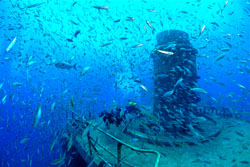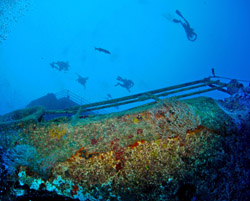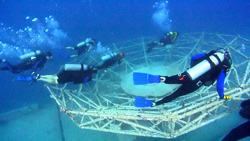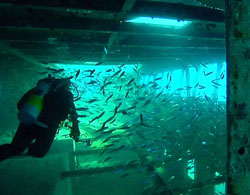WRECK OF THE VANDENBERG: A DIVER’S MECCA
KEY WEST, Florida Keys – As the Gen. Hoyt S. Vandenberg was in final preparations to be scuttled as the southern anchor of the Florida Keys Shipwreck Trail, former crew member Chuck Garrison, who served on the ex-U.S. military missile-tracking ship visited the vessel a last time and remarked, “Wow! This will be one helluva wreck to dive.”
Garrison has dived the WW II wreck-strewn waters of the Pacific, and agrees that the highly distinctive Vandenberg, now the world’s second-largest ship ever sunk to create a reef, features dozens of dive points to interest novice and seasoned recreational divers.
Sunk to the bottom in under two minutes' time on May 27, 2009, the Vandenberg measures 10 stories high in the water column: the keel the deepest, at approximately 145 feet. It is at the top of the structure that most of the ship’s interesting attributes are located, some purposely cut from one part of the ship and welded elsewhere to make attention-getting dive spots from bow to stern, all trimmed to reach within 40 to 50 feet of the surface.
For divers starting from a vantage point at the bow and moving aft, the kingpost and foremast are immediately eye-catching, and already a popular underwater photo op for dive buddies, and each serve as both a rest platform and decompression stop for advanced and technically trained divers on ascension from deeper dives.
As divers swim aft, they'll see the bridge, symbolizing the ship’s intriguing maritime history: mounted at the top of the wheelhouse is a telescope that was part of the star-tracking systems during Vandenberg’s active duty.
Behind the bridge and the main mast is the smaller of two iconic radar dishes, another eye-grabbing feature. Next is the No. 1 barbette, a heavy steel structure in the shape of a pedestal used to protect artillery gun turrets on military ships. Aft of the No. 1 barbette is the larger radar dish, which in the 1999 movie “Virus” provided quite an explosive sequence when a laser from space blew the dish off the ship. It’s indeed intact, having popped off during descent on sink day, though it has again been safely secured to the vessel and already a breeding shelter for fish.
All dive spots along the top structure are open, free from obstruction and can be easily maneuvered during a dive.
For divers descending to the wreck on the aft portion - the wreck is too large to see in its entirety during one dive - they can see the trimmed part of the foremast with the crow’s nest, as well as the bottom half of the ship’s smokestack. The smokestack's top half was trimmed to approximately 20 feet tall for an even profile along the ship’s superstructure, and now sits atop the weather balloon hangar at the stern.
Likely to be one of the most visited dive sites on the Vandenberg, this balloon hangar was loosely dubbed the “underwater Margaritaville,” a clubhouse tribute to the famous Parrotheads who contributed support to the Vandenberg project, aside from being fanatical fans of Jimmy Buffett, whose musical and literary fame has saturated Key West.
Though the Vandenberg is characterized as a safe, enjoyable dive for all experience levels of certified divers, those trained and experienced in light-wreck penetration are enjoying exploring the ship’s many cargo holds, stair towers, elevator shafts and hallways. At 100-plus feet, holes cut along the outside of the hull purposed to sink the ship now provide swim-through opportunities for advanced and skilled technical divers.
Because the ship is nearly two football fields long, divers cannot see end to end of the ship, yet it is possible that in one dive on the Vandenberg they'll see both shallow and deep-water fish, such as barracuda, Goliath grouper, dorado and the occasional sailfish, attracted by the clouds of bait schooling around the wreck. Of course, it takes multiple dives to get a real sense of the wreck's large scale.
Already becoming covered in green algae and invertebrates, over the course of decades the ship is to be densely populated with coral species, sponges, sea fans and sea whips. Divers will want to make this Florida Keys Shipwreck Trail entry in their logbook over and over again to see the progression of marine ecosystems as they develop.
Garrison, who attests to Vandenberg’s past, said, “There is quite a history with this old girl, a lot of miles under her belt.”
Vandenberg, as expected, sits upright on the ocean bottom.
“I’ve dived on ships before that were on their sides, and it’s not nearly as much fun,” he joked.

Diver Jaclyn Skafas swims above one of the parabolic tracking dishes. Photos by Stephen Frink.

Skafas examines the Vandenberg's superstructure. Photo by Stephen Frink.

Divers swim above Vandenberg's superstructure. Photo by Haig Jacobs.

Joe Weatherby, left, and Monroe County Commissioner Mario Di Gennaro shaked hands after unfurling a Conch Republic flag. They were part of the first group of divers on the Vandenberg. Photo by Stephen Frink.
